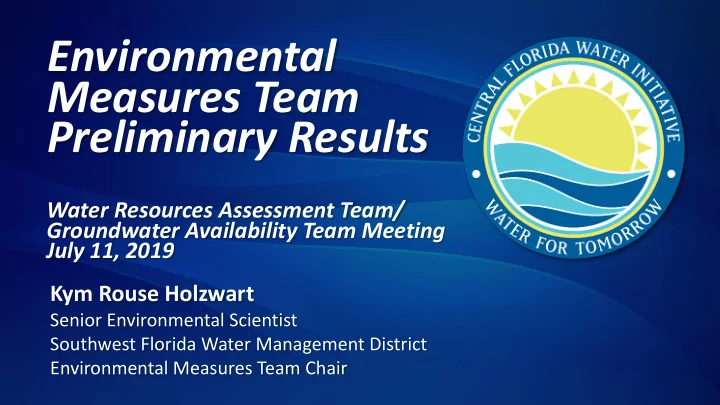

Environmental Measures Team Preliminary Results Water Resources Assessment Team/ Groundwater Availability Team Meeting July 11, 2019 Kym Rouse Holzwart Senior Environmental Scientist Southwest Florida Water Management District Environmental Measures Team Chair
Introduction and Background • Subteam of the WRAT • Water management district and public supply utility representatives • Wetlands and surface waters expertise • Determines current status of wetlands • Develops tools to analyze future groundwater withdrawals on wetlands
Approved EMT Analysis Methodology • Re-assess original Class 1 wetlands • Add new Class 1 wetlands • Original methodology with expanded Class 1 wetlands dataset and updated model
EMT Wetlands Datasets • Class 1 Wetlands: – Long-term water level data – Wetland edge and stress status known – 56 wetlands (increased by 12) – Small, non-random dataset – Water level data and stress status used to develop a statistical relationship – Statistical relationship used to estimate probability (or risk) for future changes occurring between RC and 2030 and 2040 withdrawal scenarios
EMT Wetlands Datasets • Class 2 Wetlands: – Stress status known (assessed in 2007-2012) – 222 wetlands in current analysis – Large, broadly distributed dataset – Statistical relationship used to estimate probability (or risk) for future changes occurring between RC and 2030 and 2040 withdrawal scenarios
EMT Wetlands Datasets • Class 3 Wetlands: – Thousands within CFWI planning area – Stress status not known – Location known – Statistical relationship used to estimate probability (or risk) for future changes occurring between RC and future withdrawal scenarios
EMT Wetlands Analysis • ~1 million acres of wetlands in CFWI Planning Area • ~200,000 acres of groundwater dominated Plains and Ridge wetlands and lakes analyzed • These types of wetlands are potentially more likely to be affected by groundwater withdrawals
Preliminary Results for Stressed Plains Wetlands • Wetlands with significant hydrologic alteration excluded • Surficial aquifer system model layer (Layer 1) was used Acres of Acres of Total Acres Acres of of Wetlands Stressed Stressed Stressed Wetland (Stressed Wetlands for Wetlands for Wetlands for Class and Not 2014 Reference 2030 Model 2040 Model Stressed) Condition Scenario Scenario Class 1 1,200 750 10 15 Class 2 5,700 1,800 (15) (20) Class 3 131,400 23,100 720 1,020 Total 138,300 25,650 715 1,015
Preliminary Results for Stressed Ridge Wetlands • Wetlands with significant hydrologic alteration excluded Acres of Acres of Model Aquifer Total Acres Acres of Layer Used to of Wetlands Stressed Stressed Stressed Wetland Predict (Stressed Wetlands Wetlands Wetlands Class Wetland Water and Not for 2014 for 2030 for 2040 Level Change Stressed) Reference Model Model Condition Scenario Scenario Surficial Aquifer Class 1 5,530 1,400 20 20 System (Layer 1) Class 2 11,300 3,200 310 440 Class 3 33,100 13,900 305 440 Total 49,930 18,500 635 900 Upper Floridan Class 1 400 500 5,530 1,400 Aquifer (Layer 3) Class 2 700 1,000 11,300 3,200 Class 3 2,100 2,700 33,100 13,900 Total 3,200 4,200 49,930 18,500
Probable Net Increase in Stressed Wetland Acres for the 2030 and 2040 Withdrawal Scenarios
Comparison of Probable Stressed and Not Stressed Plains Wetland Acres for Each of the Model Scenarios 25,650 26,365 26,665
Comparison of Probable Stressed and Not Stressed Ridge Wetland Acres for Each of the Model Scenarios 18,500 19,135 21,700 19,400 22,700
Questions?
Recommend
More recommend